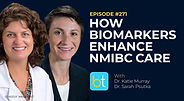BackTable / Urology / Podcast / Episode #57
Blue Light Cystoscopy: Who, When, and How?
with Dr. Anne Schuckman
In this episode of BackTable Urology, Dr. Aditya Bagrodia speaks with urologist Dr. Anne Schuckman from the University of Southern California about advantages and advice for blue light cystoscopy, a procedure performed to identify bladder tumors during transurethral resection of bladder tumor (TURBT).
This podcast is supported by:
Be part of the conversation. Put your sponsored messaging on this episode. Learn how.

BackTable, LLC (Producer). (2022, September 28). Ep. 57 – Blue Light Cystoscopy: Who, When, and How? [Audio podcast]. Retrieved from https://www.backtable.com
Stay Up To Date
Follow:
Subscribe:
Sign Up:
Podcast Contributors
Synopsis
Blue light cystoscopy causes the tumor cells that pick up dye to glow pink. According to Dr. Schuckman, urologists pick up 20% more tumors using blue light than they do with only white light. If they do not pick up these tumors with white light, the cancer is bound to recur because of unresected tumors. Using blue light cystoscopy during TURBT can lead to a more complete resection of the bladder tumor, therefore reducing the need for repetitive anesthesias events and resections, a reduction in bladder scarring and dysfunction overtime, and lessen the psychological impact of recurrent disease on patients. Blue light cystoscopy is most optimal in non-muscle invasive bladder cancer and carcinomas in situ but has not yet been extensively studied in muscle invasive disease.
Next, Dr. Schuckman shares some practice building tips for using blue light cystoscopy. She always scopes the patient with white light in the clinic first in order to identify the location of the tumor before heading to the OR. At USC, every patient receives a blue light cystoscopy during TURBT because changing workflow for each patient is hard on their system. Thus, it is easier on the staff to standardize the procedure for everyone. She then discusses the necessary materials for introducing blue light cystoscopy into a urology practice. Urologists will need to obtain Cysview, the medication that is inserted into the bladder 30 minutes to 1 hour before the cystoscopy to dye the tumor cells. Additionally, a cystoscope with white and blue light, a resectoscope, a light box, and an image generator are also necessary. She estimates that a blue light cystoscopy system will cost around $80-100k, and advises urologists to have a couple sets on hand in case of malfunction.
Finally, Dr. Schuckman shares technical advice for blue light cystoscopy. She encourages urologists to spend time washing the Cysview out of the bladder and avoiding bleeding when inserting the scope, as this can obscure the visual field. She performs a full white light cystoscopy and then a blue light cystoscopy in order to make a mental map of the bladder to determine the borders of her planned biopsy. She emphasizes that experience is the most important factor in gaining confidence with blue light cystoscopy, and notes that urologists can gain better white light cystoscopy skills through training with blue light cystoscopy as well. Finally, the two doctors agree that blue light cystoscopy is very sensitive and does have a greater false positive rate than white light cystoscopy.
The Materials available on BackTable are for informational and educational purposes only and are not a substitute for the professional judgment of a healthcare professional in diagnosing and treating patients. The opinions expressed by participants of the BackTable Podcast belong solely to the participants, and do not necessarily reflect the views of BackTable.
















